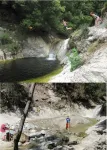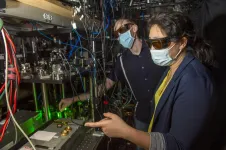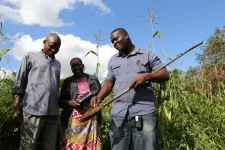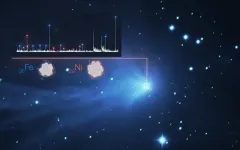(Press-News.org) For the first time, geological records have been used to reconstruct the history of Larsen C Ice Shelf in Antarctica. The ice shelf is the largest remaining remnant of a much more extensive area of ice on the Antarctic Peninsula that began to break up during the 1990s (Larsen A), and saw a huge collapse in 2002 (Larsen B). This new reconstruction enables scientists to better understand if and when the remaining ice shelf could collapse in the future.
Publishing this month in the journal Geology an international team describes how the largest remaining ice shelf on the Antarctic Peninsula, has been stable for the past ~10,000 years.
The vast Larsen Ice Shelf, twice the size of Wales, attracted global media attention, after a 5,800-square-kilometre iceberg weighing more than a trillion tonnes calved in 2017. Last month (April) it broke up completely, following a three year journey drifting from the Antarctic Peninsula to the sub-Antarctic island of South Georgia.
Over the past 25 years, several of the region's ice shelves have collapsed, including the rapid disintegration of the Larsen B Ice Shelf in 2002. The sequential breakup of ice shelves along the eastern Antarctic Peninsula is linked to warmer atmospheric temperatures which have gradually moved southward over the past 50 years. At the same time, warm ocean currents have also increased, weakening the region's ice shelves from below.
Using hot water drilling technology to penetrate through the 300 m-thick ice shelf, the team collected seabed sediment cores from beneath the Larsen C Ice Shelf in 2011. Data from these were combined with data from sediment cores recovered offshore a decade earlier, enabling the science team to reconstruct the first detailed history of the ice shelf. The authors conclude that despite modest retreat and advances of the ice shelf front there was no significant collapse during the past 10,000 years.
Lead author, marine geologist Dr James Smith from British Antarctic Survey, says:
"There is a huge international scientific effort underway to get a better understanding of what's happening to Antarctica's ice shelves. If we can understand what happened in the past we will have a sense of what might happen in the future. We can perhaps differentiate natural events that affect the ice shelves from environmental change related to human activity. This new study provides the final piece of the puzzle to the history of this last remaining ice shelf on the eastern Peninsula."
The team suggest that persistence of Larsen C, as well as Larsen B, implies that these ice shelves were more resilient to past climate warming because they were thicker, or that the heat from the atmosphere and ocean did not penetrate this far south.
In this context, the collapse of Larsen B in 2002 provided the first clue that the extent of contemporary ice shelf break-ups was starting to push further south than at any time during the past 10,000 years. Larsen C is also showing signs that it might be the next ice shelf in line to collapse.
"We now have a much clearer picture of the pattern and extent of ice shelf break-ups, both past and present. It starts in the north and progresses southward as the atmosphere and ocean warms. Should collapse of Larsen C happen, it would confirm that the magnitudes of ice loss along the eastern Antarctic Peninsula and underlying climate change are unprecedented during the past 10,000 years" says Smith.
INFORMATION:
Smith, J.A., Hillenbrand, C.-D., Subt, C., Rosenheim, B.E., Frederichs, T., Ehrmann, W., Anderson, T.J., Wacker. L., Makinson, K., Anker, P., Venables, E.J., Nicholls, K.W. (2021). History of Larsen C Ice Shelf reconstructed from sub-ice shelf and offshore sediments. Geology https://doi.org/10.1130/G48503.1.
Issued by the Press Office at British Antarctic Survey:
Athena Dinar, British Antarctic Survey, mobile: +44 (0) 7909 008516; amdi@bas.ac.uk
Livia Oldland, British Antarctic Survey, mobile: +44 (0) 7850 541910; livand@bas.ac.uk
Dr James Smith describes his research in this You Tube video here: https://youtu.be/qcxGK3tHj-I
Video of the Larsen C ice shelf just after it calved the A68 iceberg in 2017 is available from the FTP site here: ftp://ftp.nerc-bas.ac.uk/pub/photo/Larsen-Ice-Shelf/video-Larsen-Ice-Shelf-2017-18/
To download individual files: do not use an FTPClient, simply open the link with any standard web browser (Firefox, IE, Safari etc), right click on the filename and select 'save target/link/file as' to begin the download.
To download folders: use an FTP client (such as the free FileZilla). Login with the user and as the password.
Mac Users: if using a browser to access on a Mac/MacBook and you are asked to 'log in' simply click on to proceed.
For info on a Mac, Firefox usually allows you to download within the Browser, whereas Safari will try to open in Finder, from where you can drag and drop to your desktop.
British Antarctic Survey (BAS), an institute of the Natural Environment Research Council (NERC) and part of UKRI, delivers and enables world-leading interdisciplinary research in the Polar Regions. Its skilled science and support staff based in Cambridge, Antarctica and the Arctic, work together to deliver research that uses the Polar Regions to advance our understanding of Earth as a sustainable planet. Through its extensive logistic capability and know how BAS facilitates access for the British and international science community to the UK polar research operation. Numerous national and international collaborations, combined with an excellent infrastructure help sustain a world leading position for the UK in Antarctic affairs.
For more information visit our website http://www.bas.ac.uk or social media; TW @BAS_news, FB @BritishAntarcticSurvey, LI @british-antarctic-survey, IG @britishantarcticsurvey
By mapping its genetic underpinnings, researchers at University of California San Diego School of Medicine have identified a predictive causal role for specific cell types in type 1 diabetes, a condition that affects more than 1.6 million Americans.
The findings are published in the May 19, 2021 online issue of Nature.
Type 1 diabetes is a complex autoimmune disease characterized by the impairment and loss of insulin-producing pancreatic beta cells and subsequent hyperglycemia (high blood sugar), which is damaging to the body and can cause other serious health problems, such as heart disease and vision loss. Type 1 is less common than type 2 diabetes, but its prevalence is growing. The U.S. Centers for Disease ...
Boulder, Colo., USA: Deep pools below waterfalls are popular recreational swimming spots, but sometimes they can be partially or completely filled with sediment. New research showed how and why pools at the base of waterfalls, known as plunge pools, go through natural cycles of sediment fill and evacuation. Beyond impacting your favorite swimming hole, plunge pools also serve important ecologic and geologic functions. Deep pools are refuges for fish and other aquatic animals in summer months when water temperatures in shallow rivers can reach lethal levels. Waterfalls also can liquefy sediment within the pool, potentially triggering debris flows that can damage property and threaten ...
Florida State University researchers have more insight into a strange sea creature found in oceans around the world and what their presence means for the health of a marine ecosystem.
Scientists have thought that salps -- small marine organisms that look like clear, gelatinous blobs -- competed for resources with krill, shrimp-like creatures that are an important food source for many marine animals. But new research published in Limnology and Oceanography suggests that salps are actually competing for food with an organism known as a protist.
An image of a salp taken during research. New research published in Limnology and Oceanography suggests that salps are actually competing for food with an organism known as a protist. (Courtesy of ...
A heart surgeon doesn't need to grasp quantum mechanics to perform successful operations. Even chemists don't always need to know these fundamental principles to study chemical reactions. But for Kang-Kuen Ni, the Morris Kahn associate professor of chemistry and chemical biology and of physics, quantum spelunking is, like space exploration, a quest to discover a vast and mysterious new realm.
Today, much of quantum mechanics is explained by Schrödinger's equation, a kind of master theory that governs the properties of everything on Earth. "Even though ...
The amount of nutrients people get from the crops that they eat is a type of 'postcode lottery', according to new research that has analysed thousands of cereal grains and soils as part of a project to tackle hidden hunger in Malawi and Ethiopia.
A global team led by the University of Nottingham and its Future Food Beacon including academics and researchers from Addis Ababa University (AAU) in Ethiopia and Lilongwe University of Agriculture and Natural Resources (LUANAR) in Malawi, working on the GeoNutrition project, have discovered more about the relation between soils, crops and micronutrient deficiencies among people living there. Their ...
HERSHEY, Pa. -- Parkinson's disease is the second most common neurodegenerative disease and affects more than 10 million people around the world. To better understand the origins of the disease, researchers from Penn State College of Medicine and The Hebrew University of Jerusalem have developed an integrative approach, combining experimental and computational methods, to understand how individual proteins may form harmful aggregates, or groupings, that are known to contribute to the development of the disease. They said their findings could guide the development of new therapeutics to delay or even halt the progression of neurodegenerative diseases.
Alpha-synuclein ...
A new study by a Belgian team using data from the European Southern Observatory's Very Large Telescope (ESO's VLT) has shown that iron and nickel exist in the atmospheres of comets throughout our Solar System, even those far from the Sun. A separate study by a Polish team, who also used ESO data, reported that nickel vapour is also present in the icy interstellar comet 2I/Borisov. This is the first time heavy metals, usually associated with hot environments, have been found in the cold atmospheres of distant comets.
"It was a big surprise to detect iron and nickel atoms in the atmosphere of all the comets ...
Where you live may predict your long-term survival after experiencing a first heart attack. Socioeconomic factors -- such as income, education, employment, community safety and more -- have long been associated with cardiovascular health, but less is known about how neighborhood factors impact outcomes after myocardial infarction (MI), particularly among younger individuals. In an article published in JAMA Cardiology, researchers from Brigham and Women's Hospital and colleagues studied the health records of 2,002 patients who experienced an MI at or before age 50. They found that even after adjusting ...
What The Study Did: Researchers evaluated racial and ethnic diversity among obstetrics and gynecology, surgical and nonsurgical residents in the United States from 2014 to 2019.
Authors: Claudia L. Lopez, M.D., of the University of California, Davis, is the corresponding author.
To access the embargoed study: Visit our For The Media website at this link https://media.jamanetwork.com/
(doi:10.1001/jamanetworkopen.2021.9219)
Editor's Note: The article includes funding/support disclosures. Please see the article for additional information, including other authors, author contributions and affiliations, conflict of interest and financial disclosures, and funding and support.
# ...
What The Study Did: Registry data were used to examine the association between living in a socioeconomically disadvantaged area and long-term survival among patients who had their first heart attack at or before age 50.
Authors: Ron Blankstein, M.D., of Brigham and Women's Hospital in Boston, is the corresponding author.
To access the embargoed study: Visit our For The Media website at this link https://media.jamanetwork.com/
(doi:10.1001/jamacardio.2021.0487)
Editor's Note: The article includes conflict of interest disclosures. Please see the articles for additional information, including other authors, author contributions and affiliations, conflicts of interest and financial ...



